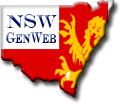|
|
Richmond-Tweed is a north-east, diverse sub-tropical region encompassing national parks, state forests, kilometres of beaches, rivers, lakes, wetlands and crystal clear streams. Six council shires comprise Richmond-Tweed - Ballina, Byron, Kyogle, Lismore, Richmond Valley and Tweed.
Richmond-Tweed GenWeb
Volunteer Required for the position of Richmond-Tweed County Coordinator. A County Coordinator maintains the county website and moderates the existing message board. This is not a difficult position and anyone with basic web editing experience and a genuine interest in the region is welcome to apply. In addition to web and query maintenance, a County Coordinator also oversees the local GenWebs within its region. This duty is non-technical as a County Coordinator operates in an advisory capacity only. Existing Local GenWeb Coordinators and non-locals are welcome to apply for the position. Ballina
(map) is a town and
local government area established on the northern shore of the Richmond River near Cape
Byron in the 1840s, Australia's most easterly point (town
population circa 16,599). It is approximately 750km north of Sydney and
205km south of Brisbane. Ballina Shire was formed by the amalgamation of Ballina Municipality and Tintenbar Shire in 1976. It includes the towns of Alstonville (population circa 4,773), Lennox Head (population circa 5,843) and Wollongbar (population circa 1,959); and the villages of Wardell, Tintenbar and Teven.
Ballina
GenWeb Byron (map) is a local government area (population circa 30,000); located about 800km north of Sydney and 200km south of Brisbane, Captain James Cook named the area Byron after John Byron. Cape Byron, a headland adjacent to the town, is the eastern-most point of the continent of Australia, and is part of a giant volcanic crater. The Cape Byron lighthouse was opened in 1901; it has the most powerful beacon in Australia. The town has several beautiful beaches and is popular with residents from various socio-economic backgrounds. It has gained a reputation for its laid back, alternative lifestyle. The area is also noted for its wildlife, with the whale watching industry a significant contributor to the local economy. Byron GenWeb Coordinator: Volunteer Required Kyogle (map) is a town and local government area located 758km north of Sydney (population circa 3,000). Situated on the Richmond River, Kyogle is the seat of its own shire. Kyogle is an Aboriginal word meaning 'place of the bush turkey'. Cattle grazing and dairy farming are the primary industries. In the early days, lumber jacking was the main reason for settlement as red cedar and hoop pine dominated the local area. Kyogle is a gateway to many National Parks including the Border Ranges National Park and Toonumbar National Park. Kyogle GenWeb Coordinator: Volunteer Required Lismore (map) is a sub-tropical city and local government area. It's traditional inhabitants were the Bundjalung people. Evidence indicates that the Bundjalung people arrived from the north of Australia around 8,000 years ago. European History of Lismore began circa 1843 when a pastoral run, covering an area of 93km˛, was undertaken by Captain Dumaresq. The run was stocked with sheep from the New England area. Ward Stephens took up the run in the same year, but the sub-tropical climate was unsuited to sheep grazing, so the run was eventually abandoned. In January 1845, William and Jane Wilson took over the run. Jane Wilson was responsible for naming it after Lismore in Scotland where the couple had honeymooned. The Wilsons were Scottish themselves having arrived in New South Wales in May 1883. In 1855, a surveyor by the name of Frederick Peppercorne was instructed by Sir Thomas Mitchell to determine a site for a township in the area. The chosen site was William Wilson's homestead paddock; the area was proclaimed the 'Town of Lismore' in the NSW Government Gazette on 1 May 1856. Lismore GenWeb Coordinator: Volunteer Required Richmond Valley (map) is a local government area in northern New South Wales. Named after the Richmond River which runs through the region, the council seat is located at Casino. A rural area dominated by cattle, sugar cane and wheat crops, the Richmond Valley is also known for its pecans. Villages in the shire include Coraki, Woodburn, Evans Head and Stratheden. Richmond
Valley GenWeb Tweed Valley (map) is administered by the Tweed Shire Council. The European history of the Tweed Shire began in 1823 when the Tweed River was explored by John Oxley. After sheltering on Cook Island (4km from the River's mouth), Oxely travelled 11km up river. In 1828, Captain H J Rous explored 50km up river. Settlers began to arrive in the late 1820s; the first of which where 'cedargetters' who harvested and exported the Great Red Cedar to England. Tweed Shire includes a number of Gold Coast suburbs such as Tweed Heads, Banora Point, Kingscliff, Fingal Head, Chinderah and Terranora; as well as a number of towns and villages such as Murwillumbah (population circa 7,596), Bogangar (population circa 3,043), Pottsville (population circa 2,585), Burringbar (population circa 332), Tumbulgum (population circa 360) and Uki (population circa 211). Tweed GenWeb Coordinator: Volunteer Required |

